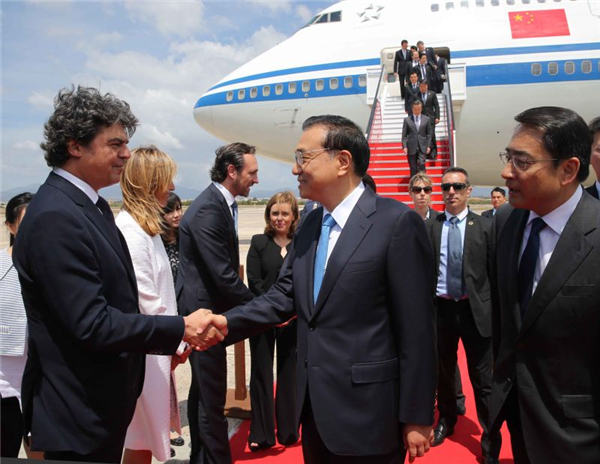China balances Silk Road strategy in Latin America
- By Tim Collard
 0 Comment(s)
0 Comment(s) Print
Print E-mail China.org.cn, July 7, 2015
E-mail China.org.cn, July 7, 2015
|
|
|
Chinese Premier Li Keqiang, center, leaves Santiago de Chile Airport to return to China as he wraps up a nine-day visit to four Latin American countries, namely Brazil, Columbia, Peru and Chile, on May 26. On his way home, during a technical stop in the Spanish island of Mallorca on May 27, he held talks with Spanish Deputy Prime Minister Soraya Saenz de Santamaria. [Photo provided to chinadaily.com.cn] |
So much attention has been paid to China's new international economic strategy based on the AIIB and the "Belt and Road" initiatives that one can at times forget about the other relationships that form the totality of China's opening to the world at large.
To a certain extent, Premier Li Keqiang's recent visit to four Latin American countries - Brazil, Chile, Colombia and Peru - slipped beneath the radar of the world's commentators. On the surface, it may look as though Latin America is too distant from China to assume a high priority in the country's global strategy concentrating on physical infrastructure, which inevitably emphasises the regions in geographical proximity to China.
But the idea that China's links with Latin America are less significant than the connections represented by the old Silk Road is erroneous and short-sighted. The great days of the Silk Road lie far back in the first millennium, whereas the trade routes between East Asia and South America were hugely important only three or four hundred years ago. After the Pacific sea lanes were opened up by Spanish explorers in the mid-sixteenth century, huge trade volumes along them based on the vast output of South American silver mines funded the purchase of large quantities of Chinese-made goods. The link was not directly to China; the Spanish set up their entrepot in Manila, capital of the colony they established in the Philippines, but the Chinese were the main traders at the eastern end of this route.
At the time when Britain and France were beginning to establish a mighty trading empire that encompassed Europe, Asia and Africa, a Sino-Hispanic nexus was flourishing in the background, one which bypassed Europe altogether. This explains why there is to this day a strong ethnic Chinese presence all over Southeast Asia, and incidentally, why there is also a long-established ethnic Chinese presence in many Latin American port cities and trade hubs. When Premier Li visited Peru he must have seen a lot of familiar faces, since it is estimated that 10 percent of the Peruvian population has some Chinese ancestry. Mexico, too, has a strong and cohesive Chinese community, as Mexico was one of the main trading regions in the Spanish colonies.






